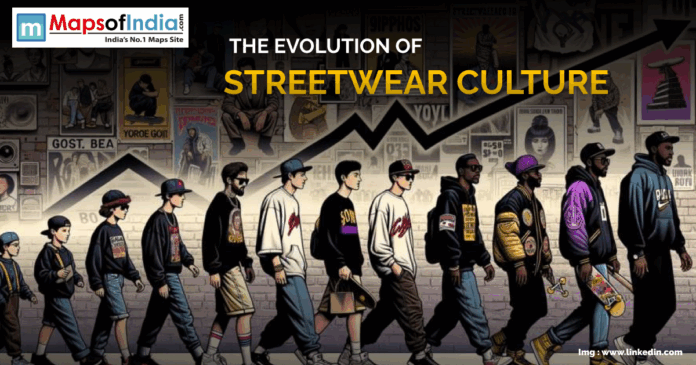Wearing streetwear has become the new way of fashion. This has become the most influential movement in fashion. Wearing streetwear is more than just a fashion sense. Through this way of fashion, people show their identity, creativity, and culture. When this fashion sensation started, it started as niche apparel from subcultures, and now it has grown into a global clothing industry which has a blend of style, music, art, and lifestyle. To understand the evolution of streetwear around the world, one must trace its journey from the beginning in underground communities to how it made its way into luxury runways.
Origins of Streetwear
The fashion of streetwear emerged in the late decade of 1970s and early 1980s. This fashion scene started with skateboarding and surf communities in California, USA. Small brands started to create comfortable and durable clothes that would suit the active lifestyle those people had. During the same time, hip hop culture was making a big impact in New York, influencing street fashion. Baggy jeans, sneakers, and oversized tees slowly became a form of self-expression among these people. These original roots of fashion connected streetwear style with youth identity and rebellion.
Influence of Skate and Surf Culture
When you look at the way streetwear culture was shaped, you will find that Surf brands like Stüssy played a key role in it. The tees used by surfers Shawn Stüssy started printing his name on T-shirts. This way, the start of logo-driven clothes design started, which over time became central to streetwear. The culture of skateboarding also added its own aesthetics to this. Skaters prefer wearing loose-fitting clothes, which help them in movement and are durable. Their clothing style has a combination of practicality with individuality. This mix of two different cultures of surf and skate fashion has been able to create the early blueprint for streetwear fashion.
The Role of Hip Hop
Hip hop has played an important role in developing streetwear fashion in powerful ways. Various artists use their way of fashion to express their way of confidence, identity, and resistance. As the sense of this fashion started to develop, tracksuits, bucket hats, and sneakers slowly became iconic symbols. Various larger brands, like Adidas, gained popularity when they started associations with various hip-hop groups. Slowly, streetwear started to become part of a cultural movement that blends music, art, and lifestyle with clothes. This deep connection with the culture made it more than just a fashion. This has become a language of community.
The Rise of Japanese Streetwear
Japanese designers played an important role in making streetwear a global sensation. In the 1990s, various Japanese brands like A Bathing Ape (BAPE) introduced bold graphics and camouflage designs on tees. Japanese streetwear has a combination of Western influences with local creativity in these tees. At the same time, Harajuku became a hub for experimental fashion sense that influenced streetwear designers across the world. This Japanese approach toward the clothing scene shows how streetwear has evolved into a mix of art, luxury, and pop culture.
Streetwear and Luxury Fashion
The beginning of the decade of the 2000s turned out to be a turning point in the luxury fashion industry. The fashion brands across the world started to collaborate with various brands to come into the streetwear market. The collaboration made a symbolic shift like the collaboration that took place between Louis Vuitton and Supreme in 2017. With this collaboration happening between various brands, streetwear to changing from underground clothing scenes to luxury runways. Luxury brands, when they collaborated with streetwear makers, saw the cultural power of streetwear and its appeal to the younger generation. This blurred the line between casual clothing and high fashion.
The Hypebeast Era
The rise of social media and digital culture has started the hypebeast era. Streetwear has started to be associated with exclusivity and hype. Nowadays, various brands are releasing limited editions of streetwear that generate excitement and long queues among youth. Resale markets of these clothes are flourishing as items sell out within minutes. Social media platforms like Instagram are making this trend big and giving more visibility to niche brands. The hypebeast phenomenon showed how streetwear had become a global industry, which is now driven by scarcity and demand.
Streetwear as Identity
From the beginning, the fashion of streetwear has always been tied to identity. Through wearing these clothes, they have allowed individuals to express who they are and what their views are. Some people feel that wearing clothes of certain brands connects them with a community. Streetwear was never about a style statement but about belonging. It communicates status, creativity, and values. Wearing this is deeply personal, but at the same time is universally recognised as a cultural code.
Gender and Streetwear
From the beginning, the scenario of streetwear was dominated by male-only clothing. But over time, this has changed. Nowadays, Women have become leaders in shaping various mainstreet trends and designs across the world. In this digital era, many female designers and social media influencers are redefining how streetwear is seen across the world. Unisex collections and inclusive styles are showing the broader social changes happening around us. This evolution, which has been adapted by streetwear, shows cultural shifts in gender roles and representation.
Streetwear Beyond Clothing
The evolution of streetwear has made it more than just a fashion sense. It has expanded into lifestyle. This way of clothing has influenced art, music, gaming, and even home décor across the world. Various big brands collaborate with artists and musicians to create cultural experiences through their clothes. Pop-up stores and limited events around this clothing style turn shopping on the street into social gatherings. Streetwear has not been limited to just what you wear. They have now turned it into about how you live and the values you express.
Final Thoughts
From the start of streetwear sensation in America now they have now travelled from subcultures to the global stage. Wearing these kinds of clothes, individuals are trying to reflect identity, music, and art through them. But at the same time, they are adapting to social and technological change happening around us. Looking from surfboards and skateparks to now luxury runways, the fashion of streetwear has reinvented itself while keeping its authenticity at its core. The evolution happened in this fashion, showing how the culture of streetwear fashion is never just about clothing, but this is more about culture. The popularity of streetwear is proof that creativity thrives when it is connected to people and their stories.





